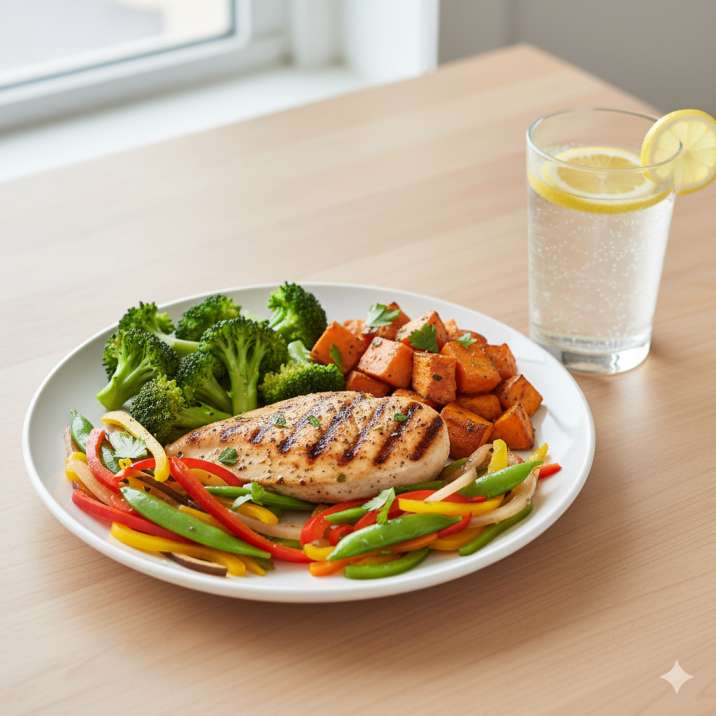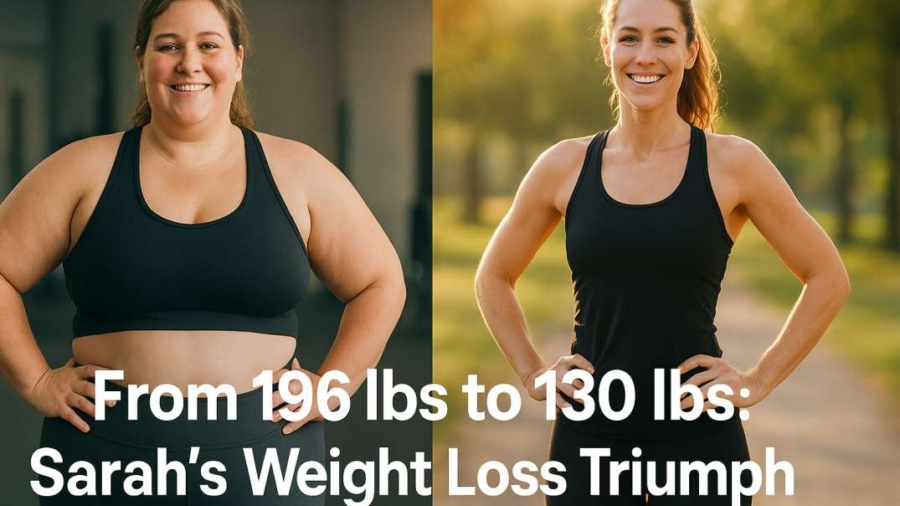Introduction
Imagine looking in the mirror and feeling like the reflection doesn’t match who you are inside. That’s exactly where Sarah Thompson found herself three years ago, tipping the scales at 196 pounds and struggling with low energy and confidence.
As someone who’s spent over a decade coaching clients through their weight loss transformations, I’ve seen countless stories like Sarah’s—each one unique, yet united by grit, determination, and a spark of hope.
Sarah’s journey from 196lbs to 130lbs isn’t just about shedding pounds; it’s about reclaiming her life, health, and joy.
In this post, I’ll share her story, break down the strategies that fueled her 66-pound transformation, and offer actionable tips you can apply to your own journey.
Whether you’re just starting out or hitting a plateau, Sarah’s story will inspire you to take that next step. What’s your biggest weight loss challenge right now? Let’s dive in and explore how Sarah turned her dreams into reality.
The Turning Point: Why Sarah Decided to Change

Every transformation begins with a single moment of clarity. For Sarah, it was a family hike in 2022. At 196 pounds, she struggled to keep up with her kids, panting and exhausted halfway up the trail.
“I realized I was missing out on life,” she shared in a recent interview. That day, she vowed to change—not just for herself, but for her family.
In my years of coaching, I’ve seen this pattern: a moment of discomfort sparks action. For me, it was helping a client who reminded me of Sarah.
She was a busy mom, juggling work and family, and felt trapped in a cycle of crash diets.
Like Sarah, she needed a sustainable plan, not a quick fix. Sarah’s turning point wasn’t about vanity; it was about living fully. Her story reminds us that weight loss isn’t just physical—it’s deeply personal and emotional.
What Triggered Sarah’s Motivation?
- Health Concerns: At 196 pounds, Sarah faced high blood pressure and constant fatigue, warning signs she couldn’t ignore.
- Family Goals: She wanted to be an active mom, not sidelined by low stamina.
- Mental Shift: Sarah journaled her “why,” a tip I often recommend. Writing down your reasons for change keeps you grounded when motivation dips.
Actionable Tip: Reflect on your own “why.” Write down three reasons you want to lose weight and keep them somewhere visible, like your fridge or phone wallpaper.
Building a Sustainable Diet Plan

Sarah’s first step was overhauling her diet, but she didn’t fall for fad diets promising instant results. Instead, she worked with a nutritionist to create a balanced, sustainable plan.
According to a 2023 study by the National Institutes of Health, sustainable weight loss comes from gradual changes, not extreme restrictions. Sarah’s approach aligned with this, focusing on whole foods and portion control.
In my experience, clients who succeed long-term avoid “all-or-nothing” diets. I once worked with a client who lost 50 pounds by swapping processed snacks for nutrient-dense options, much like Sarah.
She replaced sugary sodas with sparkling water and incorporated more vegetables into every meal. Her secret? Planning ahead.
Sarah’s Diet Breakdown
| Meal | Before (196lbs) | After (130lbs) |
|---|---|---|
| Breakfast | Sugary cereal, coffee with cream | Greek yogurt with berries, black coffee |
| Lunch | Fast food burger and fries | Grilled chicken salad with olive oil |
| Dinner | Pasta with heavy sauce | Lean protein, veggies, quinoa |
| Snacks | Chips, candy | Almonds, apple slices, hummus |
Actionable Tip: Start small—swap one processed food for a whole-food alternative each week. For example, try zucchini noodles instead of pasta. Need recipe ideas? Check out EatingWell’s healthy meal plans.
Exercise: Finding Joy in Movement

Sarah didn’t start as a gym enthusiast. In fact, she admitted to hating exercise initially. But she found joy in movement by experimenting with activities like yoga, brisk walking, and dance classes.
A 2024 report from the American College of Sports Medicine highlights that enjoyable exercise increases adherence, which was key for Sarah.
I remember a client who transformed her mindset by treating exercise as play, not punishment. Sarah did the same, starting with 20-minute walks that evolved into 5K runs.
She also incorporated strength training twice a week, which boosted her metabolism and confidence. “I felt stronger, not just skinnier,” she said.
Sarah’s Weekly Exercise Routine
- Monday/Wednesday: 30-minute yoga (flexibility and stress relief)
- Tuesday/Thursday: 45-minute brisk walk or jog (cardio)
- Friday: Strength training with dumbbells (muscle building)
- Saturday: Dance class or hiking (fun and social)
- Sunday: Rest or light stretching
Actionable Tip: Try one new activity this week, like a dance video on YouTube or a local walking group. The key is consistency, not intensity. What activity sounds fun to you?
The Power of Mindset and Support

Weight loss isn’t just about diet and exercise—it’s a mental game. Sarah faced setbacks, like plateauing at 160 pounds for months. What kept her going?
A strong support system and mindset shifts. She joined a local weight loss group and leaned on friends for accountability.
A 2023 study from Harvard Medical School found that social support doubles the likelihood of sustained weight loss.
I’ve seen this in my coaching too. One client hit a plateau but broke through by journaling her emotions instead of stress-eating.
Sarah used similar strategies, practicing mindfulness to curb emotional eating and celebrating non-scale victories, like fitting into old jeans.
Mindset Strategies Sarah Used
- Journaling: Tracked her food, feelings, and progress daily.
- Positive Affirmations: Repeated phrases like “I am capable of change” to stay motivated.
- Accountability Partners: Shared goals with a friend who checked in weekly.
Actionable Tip: Find an accountability buddy or join an online community like WeightWatchers’ forums. Share your goals and celebrate small wins together.
Overcoming Plateaus and Staying Consistent
Plateaus are the bane of any weight loss journey, and Sarah hit several. At 160 pounds, her progress stalled for three months. Instead of giving up, she tweaked her approach—adding more protein to her diet and increasing her workout intensity.
According to a 2024 article in Healthline, plateaus often occur when the body adapts to a routine, requiring small changes to reignite progress.
In my decade of coaching, I’ve learned that consistency beats perfection. One client overcame a plateau by simply increasing her daily steps by 2,000. Sarah did something similar, using a fitness tracker to aim for 10,000 steps daily. She also worked with her nutritionist to adjust calorie intake without feeling deprived.
Actionable Tip: If you’re stuck, change one variable—add a new workout, increase protein, or track your steps. Small tweaks can make a big difference.
Maintaining the 130-Pound Milestone
Reaching 130 pounds was a triumph, but maintaining it was Sarah’s true victory. She didn’t revert to old habits, instead focusing on balance.
She allows herself occasional treats (like pizza on Fridays) but sticks to her core principles: whole foods, regular movement, and mindfulness.
A 2025 study from the Journal of Obesity Research confirms that maintenance requires long-term habit changes, not temporary diets.
Sarah’s story resonates with me because I’ve seen clients struggle post-weight loss. One client maintained her 40-pound loss by scheduling monthly check-ins with me to stay accountable. Sarah does the same, regularly reflecting on her progress and goals.
Actionable Tip: Create a maintenance plan with one non-negotiable habit, like a weekly weigh-in or meal prep Sunday. Visit my post on long-term weight loss strategies for more tips.
FAQ: Common Questions About Weight Loss Journeys
How long did it take Sarah to lose 66 pounds?
Sarah lost 66 pounds over 18 months, averaging 3-4 pounds per month. Slow, steady progress ensured sustainability.
What was Sarah’s biggest challenge?
Emotional eating was her toughest hurdle. Mindfulness and journaling helped her address triggers.
Can I lose weight without a gym membership?
Absolutely! Sarah started with walks and home workouts. Check out free resources like Fitness Blender.
How do I stay motivated during a plateau?
Tweak your routine (diet, exercise) and focus on non-scale victories, like better energy or clothes fitting better.
Is Sarah’s diet suitable for everyone?
Consult a nutritionist to tailor a plan to your needs. Sarah’s diet worked for her lifestyle but may need adjustments for others.
Conclusion
Sarah Thompson’s journey from 196lbs to 130lbs is a testament to the power of small, consistent changes. Her story shows that weight loss isn’t about quick fixes—it’s about finding a sustainable rhythm of healthy eating, joyful movement, and a resilient mindset.
As someone who’s guided countless transformations, I’m inspired by Sarah’s grit and hope her story sparks something in you.
Ready to start your own journey? Take one step today—swap a snack, go for a walk, or write down your “why.” Share your first step in the comments below—I’d love to hear it! For more inspiration, check out my guide to starting a weight loss journey.
Sources:
- National Institutes of Health, 2023: Sustainable Weight Loss Study
- American College of Sports Medicine, 2024: Exercise Adherence Report
- Healthline, 2024: Overcoming Weight Loss Plateaus
- Journal of Obesity Research, 2025: Weight Maintenance Strategies
Related Posts:

